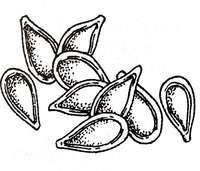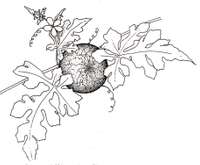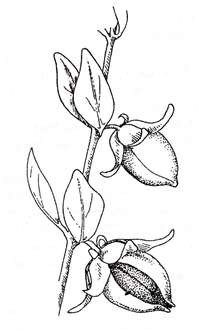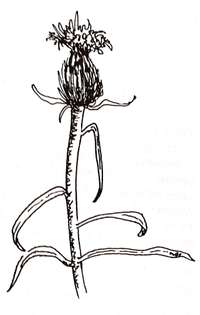- Buffalo Gourd is Another Candidate for Food and Fuel
- Cucurbit Seeds as Possible Oil and Protein Sources for Small-Scale Household Use in the Hot Humid Tropics, by Dr. Frank Martin
- Egusi Seeds are High in Oil and Protein
- Jojoba in Perspective
- Vernonia galamensis: A Potential New Industrial Oil Crop for Semi-Arid Areas of the Tropics and Subtropics
BUFFALO GOURD IS ANOTHER CANDIDATE FOR FOOD AND FUEL. ECHO has grown buffalo gourds in our "semi-arid" greenhouse for several years. Until recently I was not overly enthused about it, even though it is one of the National Academy of Sciences "underexploited" plants. It has some impressive traits, but I did not imagine that many in our network would actually use it. My enthusiasm took a quantum leap when Dave Unander told me about the work of Drs. Wayne Bragg and Eugene Schultz and Debra Duke on its use as a cooking fuel.
The buffalo gourd, Cucurbita foetidissima, is a potential source of oil for animals and humans. On barren, arid land it may match the performance of traditional  protein and oil sources such as peanuts and sunflower, both of which require more water. It is a vigorous perennial that grows wild on wastelands in Mexico and the southwestern United States. The fruits, 8 cm in diameter, are allowed to dry out and then can be "threshed." One hectare can produce 2.5 tons of seeds, which contain 30-35% protein and 34% oil. The crushed seeds yield a polyunsaturated oil (that is the "good" kind as far as cholesterol is concerned) and the pulp is fed to cattle. North American Indians used the seed for food and soapy extracts of the fruit pulp and vine for washing clothes and cleaning hides. (This was surely not for a fresh-scented soap though. As the species name implies, the vine has a foul smell!)
protein and oil sources such as peanuts and sunflower, both of which require more water. It is a vigorous perennial that grows wild on wastelands in Mexico and the southwestern United States. The fruits, 8 cm in diameter, are allowed to dry out and then can be "threshed." One hectare can produce 2.5 tons of seeds, which contain 30-35% protein and 34% oil. The crushed seeds yield a polyunsaturated oil (that is the "good" kind as far as cholesterol is concerned) and the pulp is fed to cattle. North American Indians used the seed for food and soapy extracts of the fruit pulp and vine for washing clothes and cleaning hides. (This was surely not for a fresh-scented soap though. As the species name implies, the vine has a foul smell!)
Wayne says that within a few years the plant can develop a "colony" that covers an area 35 feet across and roots of the original plant can be nearly as large as a person. By then the roots are too difficult to dig and the "mother plant" soaks up all available water. Consequently he harvests most roots about 3 months after planting, at which time they may be the size of a large carrot. He leaves a few plants because wherever a bit of soil and water is placed over the sprawling vine, roots will develop. In this way a continuing colony is sustained, which can be selectively harvested as needed. He would not let any plant get over three years old or it will absorb too much of the available water.
Wayne and colleagues found that they can harvest more biomass from the roots (11 metric tons per hectare in 3 months) than from limbs of the common dryland firewood tree crop, mesquite (6 metric tons per hectare in 12 months). Roots are cut into thin segments, with some thin slivers, and sun dried. Roots are slower to ignite than wood, which is where the slivers help. Frequent feeding with small charges of roots is desirable. Size of the grate openings may need to be increased, as the root fuel requires more draft than wood. With enough air they produce no more smoke than wood, but do produce more ash.
Like wood, roots burn with flames until about 80% consumed, then coals burn at a lower rate. Flames are about half as high as wood (charcoal has no flames). Roots burn a third as fast as wood but 3.7 times as fast as charcoal. Because of lower heating value than charcoal they only release heat 1.6 times as fast as charcoal, but water can be heated about twice as fast as on a charcoal fire. The authors attribute this to efficiency of capture of heat from a root fire being about 1.25 times greater than from charcoal.
Cooking tests with women in Mexico, Niger and Senegal have been positive and some communities are now using rootfuel in Mexico. They say the smoke is not irritating. ECHO has seed if you would like to try this plant. do not request the seed if you have a long humid season with plenty of water; other crops are much better. We have never been able to keep a plant alive at ECHO through the summer, even in our semi-arid greenhouse.
CUCURBIT SEEDS AS POSSIBLE OIL AND PROTEIN SOURCES FOR SMALL-SCALE HOUSEHOLD USE IN THE HOT HUMID TROPICS. Dr. Frank Martin wrote an article on this topic for us. You may have a copy upon request. Here is a summary of the highlights. Oils are necessary in the diet as a source of non-saturated fatty acids. They also are a concentrated source of energy, give flavor to foods and are used as a cooking medium in the kitchen. How can oils be produced at the level of the individual household in the tropics?
On a small scale, animal fats are more easily obtained from small animals than plant fats can be obtained from plants. Animal fats can be stored 1-2 weeks or more without refrigeration, but plant fats are less stable and more readily turn rancid. Most plant fats contain a good proportion of non-saturated fatty acids (palm oils are an exception) and are therefore more useful nutritionally.
Most plant oils are stored in the seeds. It is not necessary to extract the oil to obtain its nutritional value, but this is often desirable for other reasons. It is also often desirable to remove the hulls. A convenient way to use the fats without first extracting them is to prepare a vegetable curd. This is done by grinding the seeds in water, filtering, and precipitating the protein with an appropriate agent, such as lime juice, vinegar or epsom salts. Most of the oil comes out with the protein.
In the tropics there is often a shortage of oil in the diet and/or cooking oil for the kitchen. It is difficult to mature many of the most typical oil crops during the rainy season. A suitable crop for small scale oil roduction in the tropics should be an annual, or a perennial that produces during the first or second year. The oil producing fruit or seed should be available year round or the seed should be storable for oil production year round. It is also useful if the seeds are also good sources of protein.
The oil palm outproduces all other species. Its oil is principally saturated. The coconut palm is also excellent. The oil can be extracted at the household level. Because of the space and time required, however, they may not be convenient crops for the small household. The soybean, peanut and possibly winged bean are suitable for high quality cooking oil, but are very difficult to extract on a small scale. They are excellent sources of non-saturated fatty acids. Okra seed is another possibility.
Cucurbit seeds as oil sources. Cucurbit seeds [e.g. melons, squashes,  pumpkins] contain about 50% oil and up to 35% protein after dehulling. Most of their oil is non-saturated fatty acids, thus of high nutritional value. Conjugated fatty acids of some cucurbit oils make them quite useful as drying oils. The proteins are typically deficient in lysine and sulfur amino acids.
pumpkins] contain about 50% oil and up to 35% protein after dehulling. Most of their oil is non-saturated fatty acids, thus of high nutritional value. Conjugated fatty acids of some cucurbit oils make them quite useful as drying oils. The proteins are typically deficient in lysine and sulfur amino acids.
There are many precedents for using cucurbit seeds for oil in the tropics. Two species of Telfaria (oyster nut) are used for their large oily seeds in Africa. Hodgsonia (lard fruit) is a perennial vine with large, fatty seeds that has been domesticated as an oil source in China. In West Africa, seeds of watermelon are used as commercial sources of oil. These and seeds of egusi and bottle gourd are used in melon soups for their oil and protein content. (Seeds of Luffa acutangula and L. cylindrica, the angled and sponge luffa gourds, are bitter and may be poisonous.)
Most cucurbits cannot be grown except when there is a pronounced dry season because of disease problems. The most successful species for the humid tropics, from our experience in Puerto Rico, are Benincasa hispida, the wax gourd, and Cucurbita moschata, the tropical pumpkin. If fruits are carefully protected from excess moisture, Lagenaria siceraria, the bottle gourd, can also be grown.
The wax gourd is perhaps the best of the cucurbits as a source of seed oil for the hot, humid tropics. It can be produced any season of the year. Though the fruits may rot during the rainy season, they can be protected by growing the vines on trellises or by placing thick but porous supports between the fruit and the wet ground. The fruits are very large and very seedy. If the fruits are sound, they can be stored for many months, even a full year, until used. Or, the seeds can be removed and dried. Per hectare yields of seeds have been estimated in our fields as 500 kg/ha. [Ed: The fruits of some varieties are covered with a white wax that keeps microorganisms from attacking. The white flesh is eaten much as a summer squash, though is somewhat more firm.]
Seeds of cucurbits can usually be readily separated from the pulp. Sometimes a light fermentation of the wet seeds for 1-3 days is useful to clean the pulp from the seeds. Fresh, wet seeds can be chewed without further processing or are toasted. They can be used in soups with or without removing hulls. The naked seeds of the hull-less pumpkin, Cucurbita pepo, are especially desirable because they lack a seed coat. Stored seeds contain most of their nutrient content for years and are convenient for rapid use later. Dried seeds can be ground into a nutritious oily meal.
In our own laboratories we have emphasized the preparation of vegetable curds. All of the cucurbits with the exception of the Luffa species produced a very satisfactory vegetable curd, as good as tofu from soybeans. They were rich in protein and oil and contained only insignificant traces of the seed coat. However, the curds are usually very fine and difficult to separate from the whey by filtration. In the case of wax gourd, vinegar or lime juice gave a more manageable curd. We consider these results preliminary, but very promising.
Hand presses and solvent based methods of oil extraction may be used. We consider these too advanced for the smallest households, but have not yet found a satisfactory alternative.
ECHO can provide seed for luffa, wax gourd, tropical pumpkin and bottle gourd. We have not yet found lard fruit. We found seeds for oyster nut and planted it at ECHO. One vine TOTALLY covered a tall pine tree from top to the ground; because of its weed potential, we do not distribute seed of this plant.
EGUSI SEEDS ARE HIGH IN OIL AND PROTEIN. Egusi Citrullus lanatus ssp. colocynthoides) looks like a watermelon while growing. Although the 6-inch diameter round fruits also look like watermelon, the white, bitter flesh is inedible. According to Dr. John Cherry with the USDA, the dehulled seeds contain approximately 50% oil and 30% protein. They are good sources for the essential amino acids arginine, tryptophan and methionine, and vitamins B1, B2, and niacin and S, Ca, Mg, Mn, K, P, Fe and Zn. He believes it has potential as a source of calcium and niacin in low milk consuming regions. It is a very popular food in Nigeria, Zaire, and elsewhere in Africa. For example, over 360,000 hectares were grown in Nigeria during the 1970-1971 season. One visitor from Africa told me  that whenever a group of men were standing around talking their hands were usually busy dehulling egusi. It is ground into a paste and mixed with a variety of condiments to make stews, made into a substance like peanut butter, roasted, cooked in soups etc. After partial removal of the oil seeds may be ground into meal which is used to make patties that serve as a meat substitute or sold as a dry powder that is a base for soups. The Paulsons in Central African Republic tell me that dry dehulled seeds can be placed on a skillet and popped like puffed rice. They add that this is one fruit that monkeys do not bother.
that whenever a group of men were standing around talking their hands were usually busy dehulling egusi. It is ground into a paste and mixed with a variety of condiments to make stews, made into a substance like peanut butter, roasted, cooked in soups etc. After partial removal of the oil seeds may be ground into meal which is used to make patties that serve as a meat substitute or sold as a dry powder that is a base for soups. The Paulsons in Central African Republic tell me that dry dehulled seeds can be placed on a skillet and popped like puffed rice. They add that this is one fruit that monkeys do not bother.
Dr. Ezumah at IITA in Nigeria writes that egusi is traditionally intercropped (92% of the time) in Nigeria. Egusi improves the performance of the associated crops, he says, but its own yields are 50% lower than when planted by itself. Yields of 600-1000 kg/ha have been achieved in sole crop plots. (The Paulsons mention it being interplanted with corn, coffee and cotton.) After 4 weeks of growth the plants completely cover the soil surface, helping in weed control. Flowering occurs about 4-5 weeks after planting and fruits mature at 7-8 weeks after planting. Fruits are softened by beating with a piece of wood and allowed to rot for a week to make the seeds easier to remove. Seeds are washed in a running stream and dried for storage. He is working at crossing egusi and watermelon so both fruit and seed could be used. (Egusi seed is larger than normal watermelon seed.)
I asked Ruth Welch in Zaire to send us some recipes and to find out whether any animal would eat the fruits. We can forward a few recipes from Ruth to you. Local farmers said that no livestock would eat the fruits, though they had seen antelope and elephants eat them. ECHO has seed in our seedbank.
JOJOBA IN PERSPECTIVE. Jojoba (pronounced ho-HO-ba), Simmondsia chinensis, is a hardy shrub which grows wild in the Sonoran desert in northern Mexico and southwest USA. Its seeds contain an oil, which is really a liquid wax, that is very similar in properties to sperm whale oil. This kind of wax is difficult and expensive to synthesize in commercial quantities, so the demand for jojoba or sperm whale oil seems sure to continue. The oil is excellent as a lubricant under high pressures and temperatures. (The Christian Science Monitor says that a few drops of jojoba oil added to transmission fluid has been found to reduce internal temperature 20øF and in turn double the life of the transmission.) It is an excellent agent for controlling foaming in penicillin, requiring only 1/6 the amount of sperm whale oil used for the same purpose. Its main use is in cosmetics.
 Years ago, jojoba received a lot of publicity and many areas were planted with great enthusiasm and hopes of great returns. Many countries had interest in trying jojoba, which was hardly surprising: a desert shrub producing acorn-size seeds with 40% oil that sold for $200 per gallon was interesting indeed! Most plantations were established from seed, which produced plants of varying quality. (Superior plants can be propagated by tissue culture or cuttings.) Plants are either male or female, but the sex cannot be determined until flowering. Jojoba has a life expectancy of at least 100 years (quite a long-term investment!). Native jojoba plantations can be found in areas with less than 12 inches (300 mm) of rain per year, but optimal growth occurs with 15-18 inches (380-450 mm). It can withstand grazing and apparently makes good forage. Plants grow to 3 feet under water and grazing stress, but can be 9 feet tall under ideal conditions.
Years ago, jojoba received a lot of publicity and many areas were planted with great enthusiasm and hopes of great returns. Many countries had interest in trying jojoba, which was hardly surprising: a desert shrub producing acorn-size seeds with 40% oil that sold for $200 per gallon was interesting indeed! Most plantations were established from seed, which produced plants of varying quality. (Superior plants can be propagated by tissue culture or cuttings.) Plants are either male or female, but the sex cannot be determined until flowering. Jojoba has a life expectancy of at least 100 years (quite a long-term investment!). Native jojoba plantations can be found in areas with less than 12 inches (300 mm) of rain per year, but optimal growth occurs with 15-18 inches (380-450 mm). It can withstand grazing and apparently makes good forage. Plants grow to 3 feet under water and grazing stress, but can be 9 feet tall under ideal conditions.
During this time of heavy publicity, many people were tempted to plant jojoba on a large scale right away, because it takes 3-5 years for plantings to begin production. But many scientists urged caution until more was known, especially about growing jojoba in more tropical latitudes. Dr. Lemoyne Hogan at the University of Arizona knew of five-year-old plants flowering and fruiting at 4 deg. S in Brazil, so long day length is not a requirement to get fruit. Reports based on greenhouse work in Australia had suggested that some cold was needed. He stressed that jojoba is not suited if rainfall is over 30 inches (760 mm) or if soils are poorly drained. He stressed that jojoba does need nutrients. Regarding the temptation to plant widely rather than do trials first, he replied, "They had better do trials! That's what I keep urging people. It is crazy."
In 1995 we wrote David Palzkill at the University of Arizona, USA, for an updated perspective on its potential after the initial years of promotion. Excerpts from his comments follow. "A lot has changed with jojoba during the past 15 years! It is still slowly developing as a new crop; however, many large failures have occurred with attempts to grow it, especially in the warmer developing countries. I think it still has a future, but income will not be anywhere near the amounts which we spoke of in the early 1980s. Interest in jojoba remains high, but few new plantings are being made, and the market has not expanded as quickly as some had hoped--there was no dependable seed supply from year to year.
"Most of the early commercial plantings have failed, for a variety of reasons. Most were started from seed which produced very non-uniform and relatively low-yielding plantings. Many were established in areas where jojoba was not adapted. Also, it cost more to manage than was originally expected, and prices paid for the seed were lower than expected. Early promotional packages were exaggerated, both in terms of the yields and projected selling price of the seed for oil extraction. In the early years of commercial development, jojoba was promoted for many regions of the world in which no test plantings had ever been made. It has since been discovered that many of these regions do not receive sufficient cool temperatures to overcome flower bud dormancy (jojoba has a chilling  requirement, much like peaches)."
requirement, much like peaches)."
Is jojoba still a good cash crop? "It depends! For some people with existing plantings, it is. I do not think that now is a good time for anyone to start major new commercial plantings unless they can afford to lose their investment money. I do think it is still worth doing small test plantings in various regions to learn how to manage the crop, and to identify locally adapted varieties. Jojoba is also a good landscape plant for wind and dust control, and can serve as forage for livestock."
"The size of the market has not grown much in recent years, and the price of the seed has been as low as $0.50 per pound, at which US growers cannot even cover costs. Oil price is now $30-40 per gallon, not the $200 as at one time. Many of the 'potential' uses mentioned in the 1970s and 80s have not yet been realized."
What has been learned from field experiences about growing jojoba and cultural practices in the crop? "Plantation failures have occurred in many places due to insufficient chilling to overcome flower bud dormancy. We even suspect that we have a problem with this in areas of Arizona (where jojoba is native) after warm winters. There are individual plants which do not require chilling, and the amount of chilling required varies with the variety. Variety tests need to be conducted before establishing plantings in a new area. In the mid-1980s, frost was a severe problem, and much has been learned about management to avoid frost damage. Mechanical harvesters have been developed and are in use; however, improvements are still needed. Superior varieties have been developed by several groups (in Arizona, Australia, Israel, California), but are not yet in wide use. Procedures have been improved for asexual propagation by cuttings or tissue culture, and if interest increases again, it will be possible to propagate desired clonal varieties fairly quickly. Problems with insects, diseases, weeds, salinity, etc. have been encountered."
VERNONIA GALAMENSIS: A POTENTIAL NEW INDUSTRIAL OIL CROP FOR SEMI-ARID AREAS OF THE TROPICS AND SUB-TROPICS. Researchers have been working since 1983 to make vernonia a commercial crop in Zimbabwe. This plant holds potential to bring income to the poorest semi-arid regions of the country; it has grown in areas with less than 600 mm rainfall and thrives in sandy soils. Vernonia is a weedy annual, wild in much of tropical Africa, resembling a thornless thistle. It is grown for its seeds which contain 40% oil, of which 80% is a "naturally" epoxidized vernolic fatty acid. There is a large industrial market for synthetically epoxidized vegetable oils (such as linseed or soybean), but the  epoxidation process is expensive. Vernonia oil (VO) is epoxidized already, and may be able to fill some of those market niches. VO is also much less viscous than the synthetically epoxidized oils. The latter are semi-solids at 50 deg.F (10 deg.C) and can no longer be poured at 32 deg.F (0 deg.C), while VO can be poured even below the freezing point.
epoxidation process is expensive. Vernonia oil (VO) is epoxidized already, and may be able to fill some of those market niches. VO is also much less viscous than the synthetically epoxidized oils. The latter are semi-solids at 50 deg.F (10 deg.C) and can no longer be poured at 32 deg.F (0 deg.C), while VO can be poured even below the freezing point.
Where might the market be? Several possibilities are being researched at universities and industrial laboratories right now. Most have to do with its special physical properties, especially the fact that the "epoxy" structure is highly reactive with certain chemicals, unlike most fatty acids which are not epoxidized. Eastern Michigan University's Coatings Research Institute (CRI) foresees the possibility that one pint (one half liter) of VO could be used in each of the 325 million gallons of alkyd-resin paints produced each year in the U.S.A. alone. The solvents that evaporate from paint have been identified as major contributors to photochemical smog in California and elsewhere. The low viscosity of vernonia oil should make it a good solvent in paint manufacture and the highly reactive epoxy group will cause it to become chemically bound in the dried paint rather than evaporating into the atmosphere. Other potential uses include lubricants, adhesives, plastic formulations, protective coatings, cosmetics, detergents, a raw product for nylons, and much more.
The meal that is left after expelling the oil contains 43% crude protein. No feeding trials have been done (in May 1996), but research on use of the meal as an animal feed is underway.
A porous, well-drained soil is essential. Vernonia will not grow on heavy clay. There have been no major problems with insects, nematodes, or disease. It tolerates full sun and can also grow in partial shade. It should be suitable for agroforestry, serving as an annual cash crop while trees are getting established. I asked Dr. Robert Perdue, who has worked with vernonia for many years, about its weed potential. "I have never seen it as a weed in farmer's fields. A West African variety does become a weed, but we [are not using] that one."
Collaborative efforts have been focused on the vernonia trials at Africa University in Zimbabwe, where research is centered and a seed oil processing facility has been established. The major problems reported in 1996 were crop loss due to winter frosts and up to 50% seed loss during post-harvest treatments. The primary needs are a better understanding of the agronomic requirements (including optimum fertilization) and a day-neutral cultivar which can grow during the summer months to take advantage of the rains from November through early April. (Vernonia is a short-day plant, flowering only in April in Zimbabwe regardless of its planting date. Currently, irrigation must be used as seeds are sown in February and harvested in August. A daylength-insensitive plant could be planted earlier to coincide with the rainy season.) There are several promising germplasm lines for early-maturing or day-neutral varieties. There is still much work to be done on market development for vernonia oil, but some progress has been made.
If a market suddenly becomes available, the person who has learned the basics of production and has accumulated some seed will be in a profitable position. (If you want to do a modest trial, write ECHO for some seed for trial.) Those who develop a serious interest should contact Dr. Folahan Ayorinde, Dept. of Chemistry, Howard University, Washington, D.C. 20059, USA; phone 202/806-6908; fax 202/806-5442; e-mail ayorinde@cldc.howard.edu; or Dr. Fanuel Tagwira, School of Agriculture, Africa University, P.O. Box 1320, Mutare, ZIMBABWE; e-mail tagwira@africau.uz.zw.